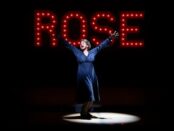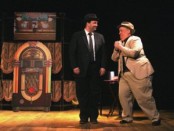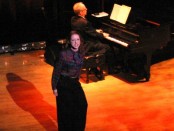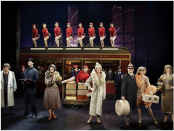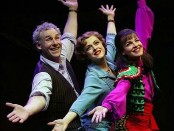Jule Styne
Born December 31, 1905, London, England – Died September 20, 1994, New York City
With the scores of such Broadway classics as Gentlemen Prefer Blondes, Peter Pan, Bells Are Ringing, Gypsy and Funny Girl to his credit, composer Jule Styne ranks as one of the undisputed architects of the American musical theater. Although he was born in London’s East End, Styne’s family moved to the United States in 1912.
http://www.julestyne.com
On The Town with Chip Deffaa: At “New York, New York,” “Some Like It Hot,” and Seth Sikes & Nicholas King’s Nightclub Act
In the last few weeks I feel like I’ve been stepping back in time—in a nice way. I’ve enjoyed seeing the new Broadway musicals "New York, New York" (set in 1946-47) and (with some definite reservations, which I’ll get to shortly,) "Some Like It Hot" (set in 1933). And although the current nightclub act of Seth Sikes and Nicolas King is set in the present, most of the Great America Songbook numbers that they sing were written long before they were born; and they put those numbers across with terrific razzle-dazzle showmanship—the kind you always hope to see in clubs but all-too-rarely do. [more]
Richard Holbrook: “Christmas Magic in the Big Apple”
"Christmas Magic in the Big Apple" continues Richard Holbrook's many years of presenting Christmas season shows. What sets his productions apart from many other performers is his view that this time of year is a time for celebrating family and friends. It is not simply a time of religious holidays but more of an all-encompassing recognition of the joyous spirit that moves people to engage with one another in a celebration of life. His shows are a creative mix of holiday songs with a universal theme. Holbrook commented, “Not everyone celebrates Christmas, and I don't want people coming to my show being made to feel uncomfortable." His playlists over the years have exemplified that view, with the current show being the latest in the series. [more]
On the Town with Chip Deffaa: On Fanny Brice and “Funny Girl”
I’ve often told friends what an impact "Funny Girl" had on me. That was the show that made me fall completely, utterly, and permanently in love with Broadway. I was a teenager when I saw it—not quite 15. I started taking odd jobs to make some extra money; I stopped buying comic books; I began skipping school lunches, too—I was trying to save every possible penny so I could buy Broadway theater tickets. Theater became my top priority. And as often as possible, I would go to see another Broadway show. (Broadway was far more affordable then than it is now, and I was eager to check out everything—musicals, comedies, dramas. I could often get tickets to shows—up in the balcony--that didn’t cost much more than tickets to movies.) "Funny Girl"—more than "My Fair Lady" or any other show I appreciated—was what got me really hooked on theater. And I’m still grateful for that. [more]
Funny Girl
Beanie Feldstein’s clunky rendition of “I'm the Greatest Star” crystalizes the absurdist dimension of this off-kilter first Broadway revival of the 1964 musical, "Funny Girl." With her nasal, often muffled singing, oddly emphatic line readings and smug mugging, in no way does she suggest a great star, yet this nearly three-hour show is centered around her. It instantly deflates with her wan introductory “Hello, gorgeous.” She does exhibit idiosyncratic pluck and stamina throughout. [more]
A Few Thoughts on Those Needless Changes to “The Music Man”
I want to be clear. "The Music Man" is such a masterfully written musical that making some changes here and there can’t really ruin it; but changes are not needed in this show and they certainly don’t help. I believe in the old saying: “If it ain’t broke, don’t fix it!” I also believe, as Tommy Tune once told me years ago in discussing a different show, many producers and directors feel a need to tinker with shows, making changes for the sake of making changes, even when the wiser choice would be to simply leave things alone. There’s just that desire to “improve” things, whether or not the changes actually improve anything. [more]
High Button Shoes
But, fear not! The Encores! creative team—director John Rando, music director, Rob Berman and choreographer Sarah O’Gleby—found a terrific cast led by Michael Urie in the Phil Silvers’ role of Harrison Floy and Betsy Wolfe as (Mama) Sarah Longstreet, Nanette Fabray’s role (which featured the earworm ditty “Papa, Won’t You Dance With Me?”). [more]
The New York Pops – Song and Dance: The Best of Broadway
The New York Theatre Ballet performed the lovely, all-female, “Come to Me, Bend to Me” from that musical, a sweet look at pre-wedding preparations in the ancient village of Brigadoon. That troupe began with two excerpts from de Mille’s groundbreaking “Dream Ballet” from "Oklahoma!" and her “Hornpipe” from another Rodgers and Hammerstein classic, "Carousel" (1945), its fishermen bouncing about while on the hunt for female companionship. [more]
Subways Are for Sleeping
"Subways Are for Sleeping" is a valentine to New York and projection designer Lacey Erb has created atmospheric slides and streaming video of such iconic locations as Grand Central Station, Park Avenue, Rockefeller Center and the Metropolitan Museum of Art. Unfortunately, the original problem with the material has not been solved: Tom and Angie are just not very interesting. They have little or no back story and no outstanding characteristics. As was famously true in the original production, the show is stolen by the secondary leads. With their continually inventive schemes to get through each day, slacker Charlie who lives off his former friends and would-be nightclub performer Martha with her Southern accent are a total delight. Unfortunately, they are off stage most of the time. The rest of the many characters are simply walk-ons. [more]
Bar Mitzvah Boy
"Bar Mitzvah Boy" may not be a top-drawer Jule Styne musical, but Jack Rosenthal’s original story and David Thompson’s new book are excellently observed to have the ring of truth. The family chaos in planning the affair and problems precipitated by the young son’s behavior are sharply and shrewdly detailed enough to be absorbing in a way that all can relate to. Annette Jolles’ production for The York Theatre Company gets a great deal out of the material even in a version without the trappings of a full production. It is also a pleasant surprise to see an unfamiliar musical by major talents which fills in a gap in their careers. [more]
Hey, Look Me Over! New York City Center Encores! at 25
Writer-performer Bob Martin recycles his sweater-clad disaffected “Man in the Chair” character from his 2006 Broadway musical "The Drowsy Chaperone." The conceit is that he’s a disgruntled Encores! subscriber who has been chosen to pick his selections for inclusion. Mr. Martin addresses the audience to offer commentary, often tells inside jokes and interacts with the cast. Depending on one’s sensibilities, this is either an inspired or an insufferable device. However, it doesn’t mar the actual production. [more]
Hallelujah, Baby!
While the new cut-down version (performed concert style with book in hand) with nine actors instead of the original 36, now covers 100 years, rather than the sixty in the original show, it still remains a shorthand version of the history of the movement as well as the trials and tribulations of African American performers in show business. Originally written with Lena Horne in mind, when she turned it down the starring role of Georgina Franklin went to newcomer Leslie Uggams and was subsequently revised to accommodate her softer, girl-next-door persona. Although her perky, animated performance won her the Tony Award for Best Actress in a Musical, Laurents was never happy with the compromises made to the show. The more tightly written show which now focuses on four main characters still doesn’t solve all the problems inherent in the material, as directed by Gerry McIntyre it does make for fast-paced musical entertainment with a great many unfamiliar songs. [more]
Bells Are Ringing
Boycott gets to sing a bounty of scintillating songs including “It’s A Perfect Relationship,” “Is It A Crime?,” “I’m Goin’ Back” and her duets with Heuser in “Better Than a Dream” (written for the film version) and “Long Before I Knew You.” Colgan’s choreography includes witty dance numbers to “Independent,” “I Met a Girl”, “Mu-Cha-Cha,” and “The Midas Touch.” Sue and Otto have a hilarious parody of the operetta aria in “Salzburg (By the Sea),” and the singer and girls of the Pyramid Club do a clever take on a cut-rate Busby Berkeley number to “The Midas Touch.” [more]
Do Re Mi
One problem with reviving musicals from the pre-Sondheim era is that they were often created around the talent of a big, unique star like Ethel Merman, Bob Hope, Mary Martin, Al Jolson, Fanny Brice or Eddie Cantor. Unfortunately, not only are these talents not around, there are very few oversized personalities in musical theater today. Musicals Tonight!’s revival of the Jule Styne/Comden & Green musical, "Do Re Mi," runs into this problem. Originally tailored to fit comedians and singers Phil Silvers, Nancy Walker, Nancy Dussault, John Reardon, and Al Lewis, their presence is sorely missed. [more]
Broadway by the Year: The Broadway Musicals of 1941-1965
In the course of Mr. Siegel’s erudite remarks, the work of key figures responsible for these often classic musicals recurred. Composer and lyricist Cole Porter was represented by four shows, composer Richard Rodgers and lyricist Oscar Hammerstein II by three shows, as was composer Jule Styne. Most monumental was the achievement of legendary producer David Merrick who was responsible for bringing five of the shows to Broadway. [more]
Hazel Flagg
Sometimes stage properties that have been forgotten are lost for a good reason. "Hazel Flagg" is one of those shows. Jule Styne completists, however, will be glad of an opportunity to at last see this 1953 show. The one thing this show will do is send you back to the classic movie to see what all the fuss was about. [more]
Bullets Over Broadway thoughts from Chip Deffaa’s July 17, 2014 column
Some of these great old songs will be unknown to the average theater-goer of today; they are so old they might as well be new. And they are a joy to hear. What a treat it is, for example, to hear Jelly Roll Morton's "Good Old New York." This is a superior melody by a major jazz composer. It will be new to most audience-members. It's done with respect and flair. And it's a just a pleasure to hear. That number is over all too soon. [more]
Broadway by the Year: The Broadway Musicals of 1965 – 1989
"For many of us this was our golden age," said creator, writer and host Scott Siegel in his introduction that for many present devotees of the art form that this evening's presentation was very meaningful as this was the era in which they came of age seeing many of these shows in their original productions and they are quite appreciative of them. [more]
Gypsy
Within seconds after musical director Marvin Laird picks up his baton, you will know why composer Jule Styne's slam-bang overture to "Gypsy" is considered by many the greatest and the most invigorating overture ever written for an American musical (okay, so you prefer Leonard Bernstein's more highfalutin "Candide"). Know this, however, that those who do go to this "Gypsy," will hear, probably for the very last time, the sound of 24 musicians in the pit (thanks to the concessions made during the recent strike). That alone is worth the price of admission. [more]

